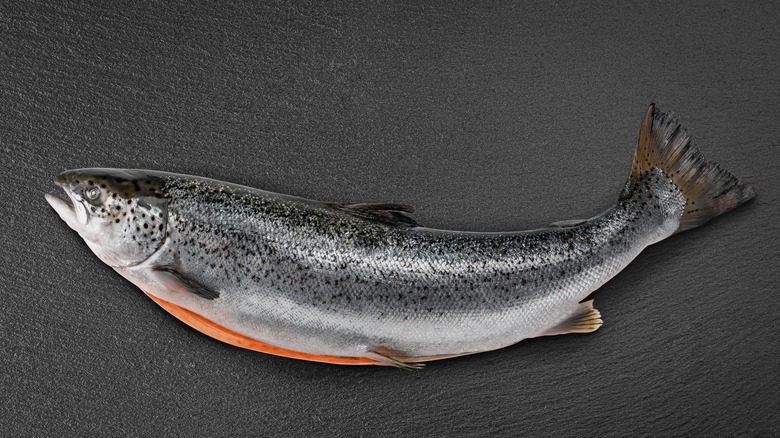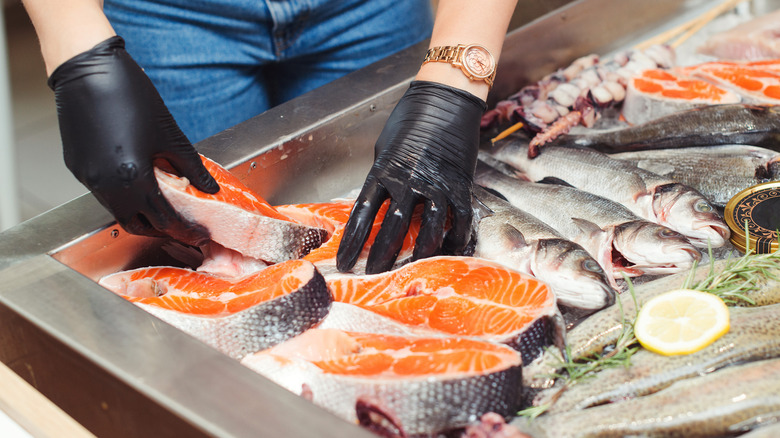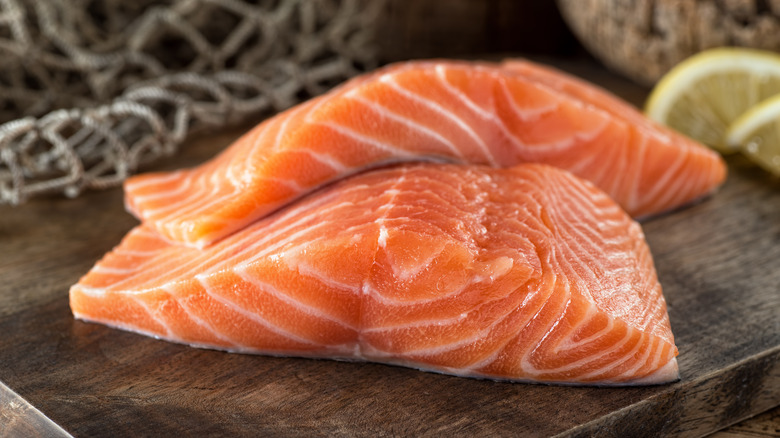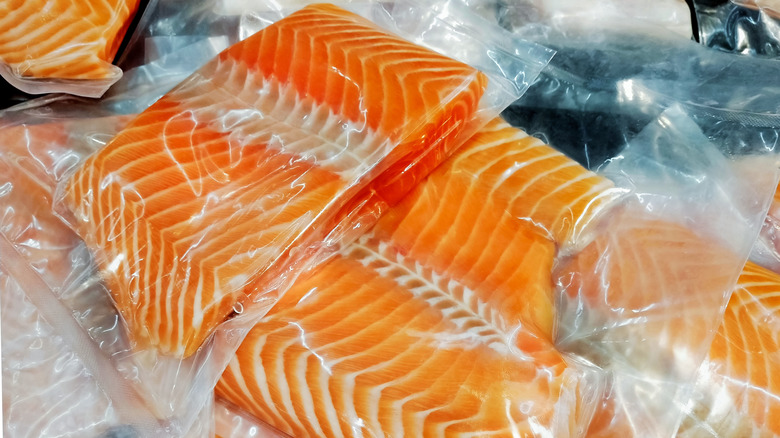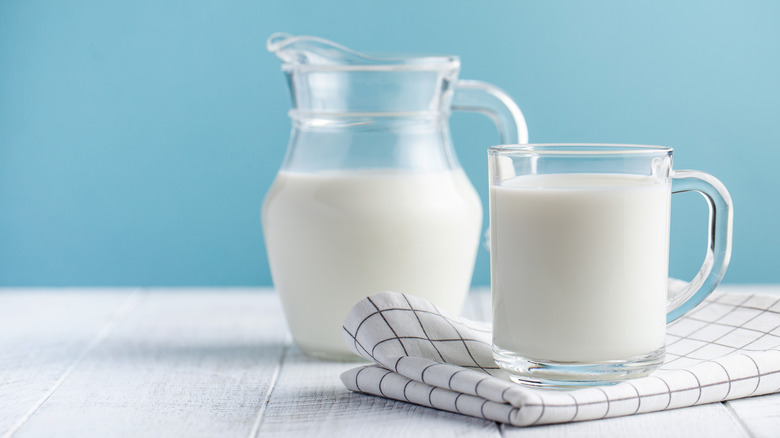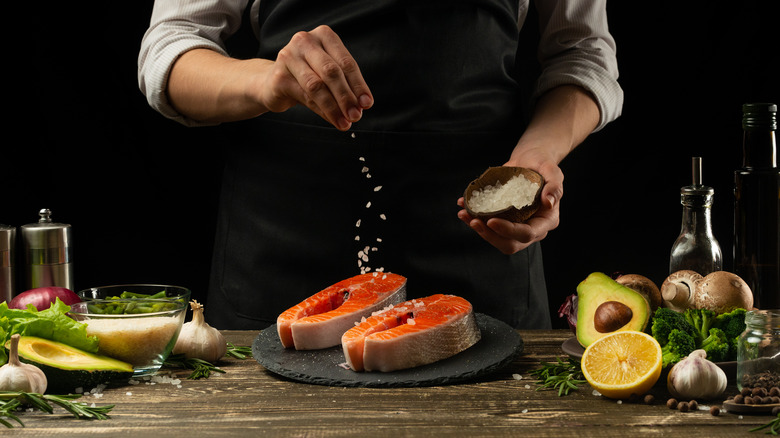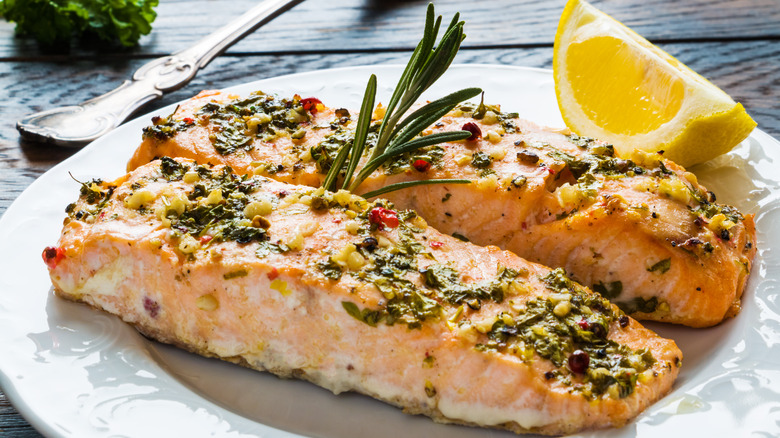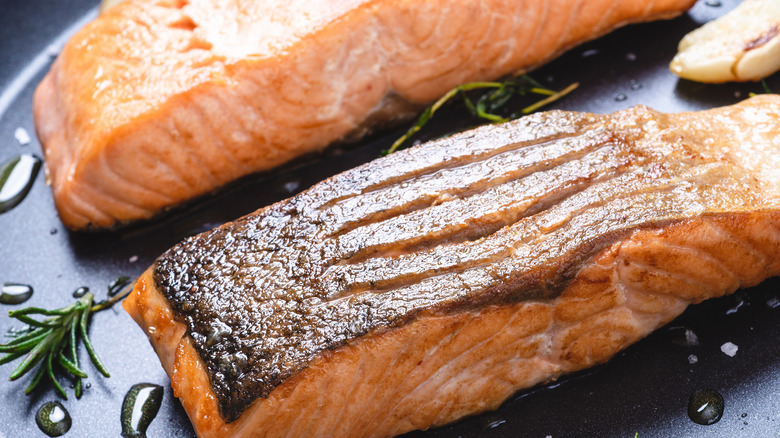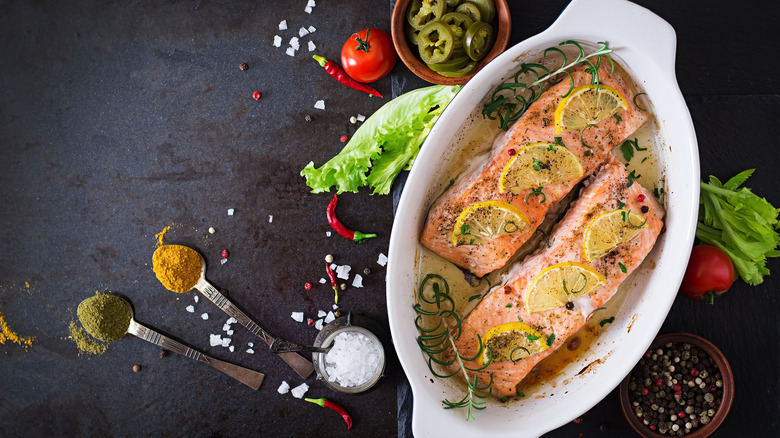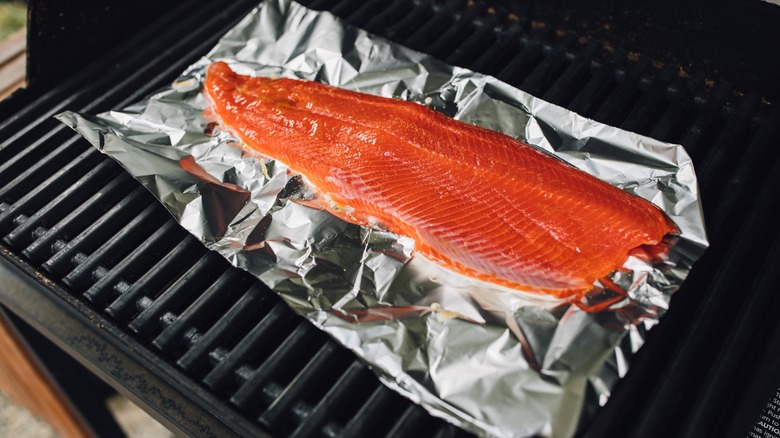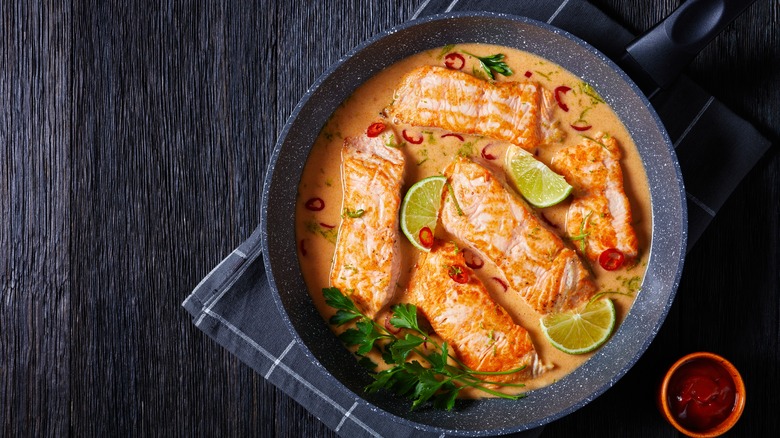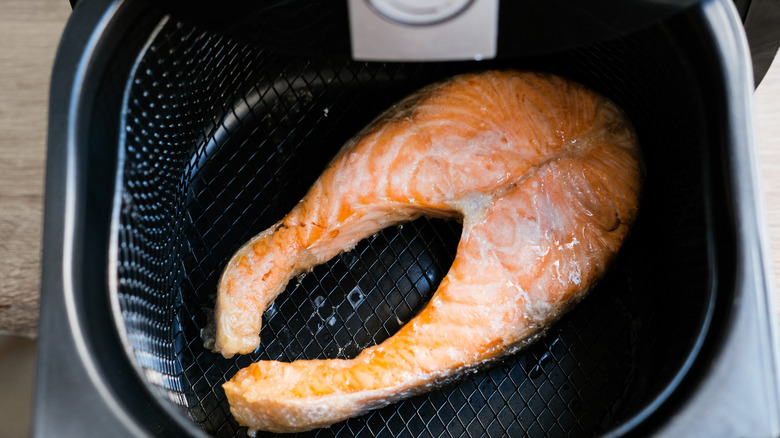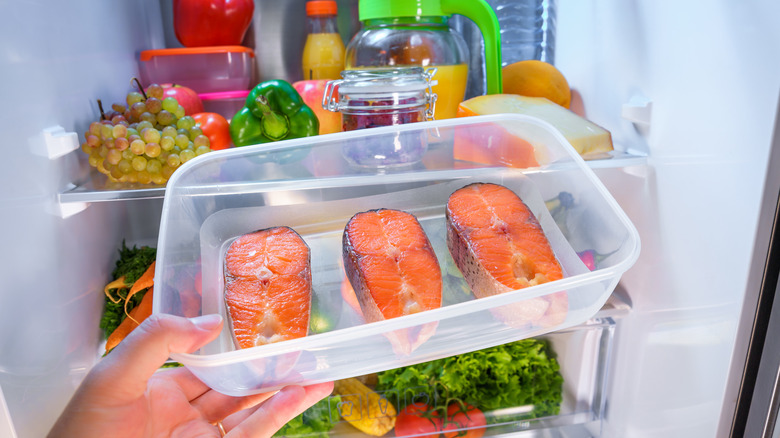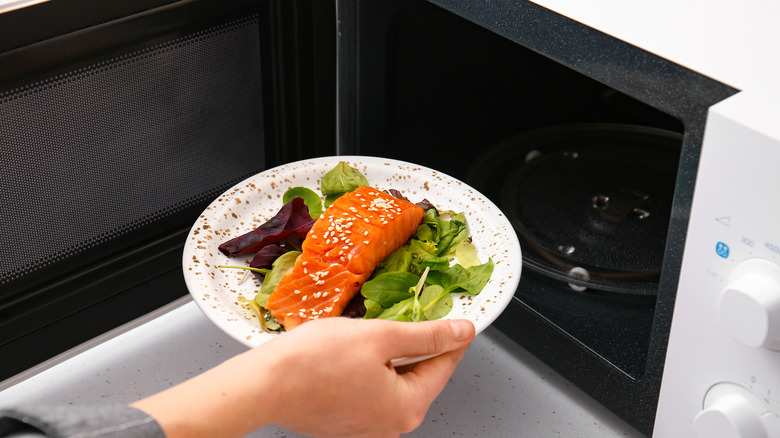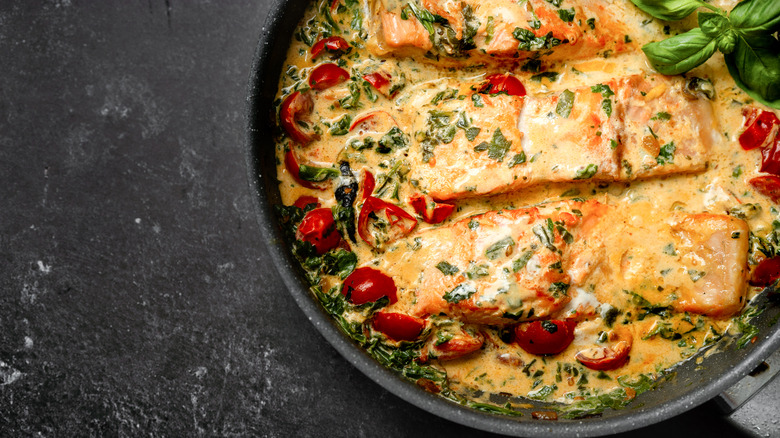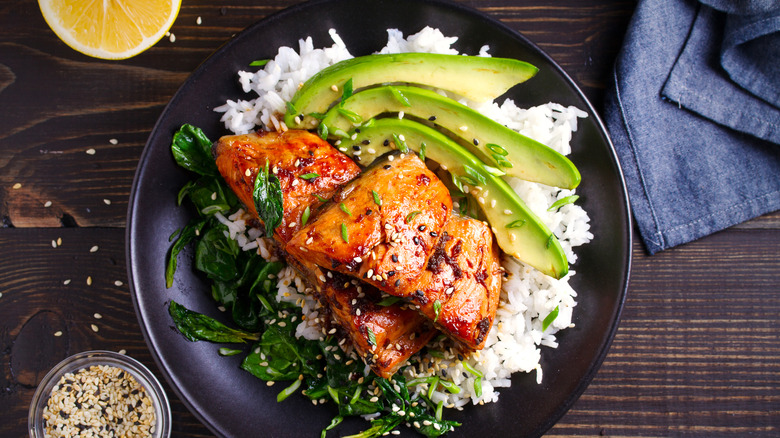15 Tips You Need When Cooking With Salmon
When it comes to seafood, Americans like to eat what they know, and what's more familiar than salmon? This pink-fleshed fish is the second most consumed seafood item in the U.S. behind shrimp. In 2020, Americans ate 2.83 pounds of salmon per person, which accounts for about 15% of the 19 pounds of seafood per capita (via the National Fisheries Institute).
People tend to lump all salmon into one category, but there are eight species of this fish, seven of which are native to the Pacific Ocean, including the wildly popular chinook aka wild king (via U.S. Geological Survey). There is only one known species of Atlantic salmon, but due to farming practices, this fish can be found in abundance from Canada to New Zealand. The different species will vary in fat content, color, flavor, and size, but they share some general characteristics, such as shimmering skin that tastes good when crisped.
With all this salmon consumption, we want you to have the tools you need to get the most out of America's favorite fish. From how to pick out the best product to how to get the much-adored crispy skin, these are our best tips for cooking with salmon.
Use all your senses when picking out salmon
When you go to the grocery store to buy salmon, you may look at premium and poor-quality fish simultaneously. So how do you know what to buy?
You may think that color is the ultimate indicator of quality. After all, salmon is known for its illustrious hue. However, color is not the only barometer to assess when buying salmon. The different species of this fish vary in color from light pink to deep red-orange. Color won't necessarily tell the fish's condition, but it will tell you what type of salmon is in front of you. We recommend doing research on the eight types of salmon to determine which one you want and then judging the fish from there.
To pick out salmon, you need to use all of your senses, not just sight. This can be said about buying fish in general. Look for imperfections, such as bruises or tears in the flesh. In our experience, this may indicate the fish is old or was poorly handled. The flesh and skin should also feel wet, not dry, and shouldn't have any slimy, milking coating. That is a surefire sign that salmon has gone bad. Finally, get your nose involved. Fresh fish should not have a "fishy" scent. If you can smell the fish through the package, pass on it. When in doubt, talk to your fishmonger. They can help you get high-quality fish.
Not all farmed salmon is bad
Farmed salmon has a bad rap, and it is not totally undeserved. There are salmon farms that gave the industry a bad reputation for the documented environmental impacts, such as increased rates of contaminants compared to wild species (via Colorado State University). Health risks have also been a concern. According to Healthline, farmed salmon can have three times as much fat as wild species. However, salmon farming has also had its benefits.
Wild salmon populations could never keep up with today's demand. Farming salmon helps relieve pressure on the wild populations. It's illegal to catch Atlantic salmon due to their protected status, so when you are eating this species (and we eat a lot of it) it is farmed (via NOAA). The good news is that you can source quality sustainably farmed salmon.
If you are worried about taste, give farmed salmon a chance. It all depends on the source. One of the most popular salmons in the world is farmed. Ora King Salmon, farmed in New Zealand, has been called wagyu of the sea. With a fat content of 25%, it has a richness that other salmon lack. The typical fat content in Atlantic salmon is 15% to 17%. No wonder so many people love this fish.
Frozen salmon can be better than fresh
It's time to clear up the misconceptions about frozen seafood. Fresh fish has the reputation of being superior in quality because it has never been frozen, but the ambiguity of this term can be misleading.
In fact, frozen salmon could be considered fresher than fish that have never been frozen. Eating frozen salmon has several benefits. When bought from a trusted source, you can feel confident the fish was frozen at its peak with its quality and nutritional value preserved. Additionally, frozen salmon is typically cheaper than fresh and has a lower carbon footprint.
Freezing salmon also makes it safer to eat raw. Salmon that is farm-raised and flash-frozen is generally considered the safest option for consuming raw, as wild fish are more likely to have parasites. If you do want to eat wild salmon raw, it's best to get fish that has been flash-frozen. With few exceptions, New York City health codes even require fish that is to be served raw in a commercial setting, such as a sushi restaurant, to have been frozen for a minimum of 15 hours at minus 31 degrees F (or minus 4 F for seven days) to help kill any parasites in the fish.
Soak salmon in milk before cooking
A longstanding misunderstanding about fish is that it stinks. Harold McGee dispelled this rumor in his book, "On Food and Cooking: The Science and Lore of the Kitchen." In the 2004 revised edition, McGee describes fresh fish as having an earthy smell, like crushed leaves or freshly cut grass. When fish is very fresh, it should not have a "fishy" smell. That strong odor that people associate with fish only occurs when it has gone past its prime.
McGee notes that fish has a compound called trimethylamine N-oxide (TMAO) on its surface. Bacteria interact with the TMAO and eventually break it down into the foul-smelling compound trimethylamine (TMA). That is the scent you detect when fish is starting to get old.
If you are buying super fresh salmon, it should not give off an odor. Still, many people are turned off by even the slightest fishy scent. If you want to eliminate the fish odor, soak your salmon in milk. A milk marinade will help neutralize odor. The proteins in milk will attach to the TMA and remove it from the fish. It really only takes a quick 20-minute soak to do the trick. The American Society for Nutrition also advises that acidic ingredients such as lemon juice or vinegar will also help eliminate the smell from the TMA.
Season salmon just before cooking
Proteins generally benefit from extra time to bond with salt. Seasoning meats in advance helps the salt permeate to the center of a piece of protein. When it comes to fish, however, this is not the case.
Salting your fish too early can turn a beautiful piece of salmon into a disappointment. Not only can salt dry out the flesh, but it can even start to cure it when left for too long. For this reason, you should season salmon just before cooking. Marinades and other seasonings, such as dry rubs, can be used, but you should do so with caution. Marinating salmon for longer than an hour can break down the muscle fibers and result in a mushy mess. Salmon has a rich flavor. Just a little salt and pepper immediately before cooking is all this fish needs to let its natural flavor shine.
The exception to this rule is with the skin. Salting just the skin side of salmon in advance will draw moisture out of the skin, allowing you to get a better crispy texture.
The white stuff on your salmon is edible but can be prevented
What's that mysterious white stuff that appears on your salmon during cooking? No, it's not a fungus or mold. The white stuff on salmon is caused by the coagulation of a protein called albumin. When salmon reaches a certain temperature, the muscle fibers contract, which releases the albumin. The protein curdles on the surface of the fish, resulting in the thick white substance you see.
Don't worry though. This substance is perfectly safe to eat. It is just not visually appealing, which is why you might want to take precautions to prevent the albumin from releasing. These two simple steps will make all the difference.
First, watch your heat level. When pan-searing salmon, it is natural to want to crank up the heat to get a crispy skin, but you won't want to maintain high heat the whole time. After the skin takes a nice sear, reduce the heat and let the fish gently finish cooking. Second, cooking salmon skin-side down will provide a protective barrier between the heat source and the flesh, reducing the presence of albumin.
Pan-sear salmon skin-side down
You already know one benefit of cooking salmon skin-side down. It reduces the likelihood of developing that unpleasant-looking albumin. For this reason, it is a good idea to always cook salmon skin-side down no matter your cooking method, but this is especially true with stovetop cooking.
Searing skin-side down is also the best way to get extra crispy skin on your salmon. Place salmon skin-side down in a hot pan and gently press on the flesh for about 30 seconds to keep the skin from curling. Resist your temptation to flip the salmon. You will get the best results from only cooking on the skin side, which should take about six to eight minutes, depending on the size of your fillets. You only need to flip the fish for about 10 to 15 seconds at the end to make sure the surface is cooked.
Another tip is that if you salt the skin (not the flesh) in advance, you will dry out the skin, priming it to turn crispy. Also reducing the heat after the initial sear will help ensure that the flesh is able to cook through without burning the skin.
Don't cover salmon when baking it
Baking is another popular way to prepare salmon. When you go to bake salmon, you may feel the urge to protect the fish (with foil, for example) to prevent the flesh from getting too dry. However, you really don't need to cover salmon when baking it in the oven.
Covering salmon will cause the fish to steam instead of roast. You might end up with soggy fish, which no one wants. By leaving the fish uncovered, it will brown on the outside, forming a slight crust, while the inside will get nice and tender.
How long it takes to bake will depend on the thickness and size of your salmon. Individual portions will cook much quicker than a whole side (the full fillet). In this recipe for lemon-garlic baked salmon, for example, you will roast a 2-pound piece of fish at 400 degrees F, which should take about 20 minutes. The key is to have a meat thermometer handy. Salmon should reach an internal temperature of 145 degrees F, although some people prefer it to be a little bit undercooked in the center. It's all up to your tastes.
Grill salmon in foil packets
Fire up the grill! Salmon can be a grillmaster's friend when handled properly. If not, you can have a mess on your hands. Fish can easily stick to the grates and doesn't flip well on the grill. Plus, salmon is particularly oily, which can lead to uncontrolled chaos over an open fire. A great tip for grilling salmon is to cook it in foil packets.
Foil provides an extra layer of protection between the fish and the direct heat. Your salmon will cook more gently, allowing the flesh to stay moist, and any glazes won't burn. It also will make cleanup super easy. To prepare salmon this way, season the fish and then fold the foil around the fillet, leaving space at the top for steam to escape. You won't even need to flip the fillet, and you won't have to scrape fish off your grill.
Even with a foil packet, it's best to grill salmon with the skin on, just like the other cooking methods we've mentioned so far. Whether in foil or on the grates, the skin will help prevent the fish from falling apart. You can even still get a crispy skin.
Season your poaching liquid
In case it isn't obvious, we advocate for eating salmon skin, and in most preparations, the skin is beneficial to the cooking process. There is one method, however, where you won't want the skin.
Poaching is a technique that involves cooking food submerged in a liquid over low heat. Since poaching is a moist-heat cooking method, we highly recommend removing the skin or buying skinless fillets. It will get soggy and flabby, and you'll lose the enjoyment of eating crunchy salmon skin.
The one step you must not forget is to season your poaching liquid. Poaching in plain water will leave you with bland fish. At the very least, add salt and aromatics like garlic, lemon, and fresh herbs directly into the liquid, and don't feel like you need to stick with water. Flavorful poaching liquids like wine, stock, or even coconut milk will help ensure you have flavorful salmon. You should still use salt and aromatics when using these other liquids.
Avoid cooking salmon in an air fryer
We get it. Air fryers are all the rage. You can get super crispy "fried" food without feeling the heaviness of deep-frying. It's also generally less involved, quicker, and way less messy. You might think that salmon would be well-suited for the air fryer given the potential for super crispy skin and a nice crust.
In reality, you probably should not cook salmon in the air fryer. You are more likely to overcook and dry out your fish. The time it takes to cook salmon can vary widely, which is not the nature of an air fryer. It's more of a "set it and forget it" type of appliance. If you do choose air fry salmon, you must pay close attention and frequently check the basket to ensure you don't overcook it. It's also best to use similar size fillets and not overcrowd the basket for the best results.
Don't keep raw salmon in the fridge for too long
How many times have you bought (or defrosted) ingredients intending to cook something on a specific day only to not follow through with your plans? Do you need to throw out the food? A lot of people fear that fish goes bad after a day, but truthfully, you have a little wiggle room. Fresh or defrosted salmon can last in the fridge for about two days. If you go beyond that and want to try your luck, make sure to inspect the fish thoroughly. These are the most common warning signs your salmon has gone bad.
Don't eat salmon that has turned grey or has a strong fishy odor. Also pitch it if you see a milky residue, dark spots, or mold. Give it a little tactile test, too. Fresh salmon should feel firm to the touch. If the fish feels soft, it's on its way out, and if it falls apart, you definitely want to abandon your dinner plans.
Don't reheat salmon in the microwave
You've got some cooked salmon in the fridge and you're wondering how it could ever be revived to its freshly cooked glory. Realistically, you can't do that, but if you want to get close, don't use the microwave. This will almost certainly dry out the fish. The absolute best way to reheat salmon is by using the oven.
Low heat is your friend. Preheat your oven to 275 to 300 degrees F and allow the fish to gently rewarm for about 15 minutes. You can even cover it with foil for better protection. If you do use the microwave, do so carefully. Cover the salmon with a paper towel and heat for 30 seconds at 30% power and then flip and do the same on the other side.
Here's our little secret. You don't even need to reheat leftover salmon to enjoy it. In our experience, poached salmon tastes great served cold as a salad topper. It's a good idea for a low-maintenance lunch, especially for work. You don't even need to break the cardinal rule of heating fish in the office microwave and you will still get the enjoyable flavor of the fish.
Salmon pairs with a variety of flavors
Salmon is such a versatile ingredient. It goes well with a variety of cooking preparations and ingredients. It could be said that salmon, not tuna, is the true chicken of the sea. Like the omnipresent poultry, salmon can insert itself into practically any cuisine across the world and feel at home.
From creamy and mild to bold and spicy, salmon crosses the flavor spectrum (and the pH scale). It loves acid and basic ingredients alike. Let's first look at this salmon Florentine recipe. This simple dish with Tuscan inspiration pairs the fish with a cream sauce that contains garlic and spinach.
Another example is this recipe for spicy honey-glazed salmon. With a little sweetness from honey and heat from chili flakes, this dish brings extra umami in the form of soy sauce, an acidic and salty ingredient with Chinese origins. The flavor profiles of these two dishes widely differ, but they demonstrate the flexibility of this fish.
Try these salmon recipes
In less than one second, Google can generate over 400 million results for salmon recipes. How could you possibly ever know which ones are worth cooking? To help you feel less overwhelmed, we are sharing a few of our favorites. While not an inclusive list of all that this fish has to offer, these recipes can be your starting point.
We love this miso salmon recipe, which calls for marinating the fish with miso paste, rice vinegar, soy sauce, brown sugar, and chili flakes. This is a very simple recipe, but make sure to take our advice and not leave the salmon in the marinade for too long. Thirty minutes should be enough time for the fish to absorb the flavors.
Glazing is another great way to add flavor to salmon. In this recipe for bourbon-glazed salmon, you will make a thick glaze by reducing bourbon alongside brown sugar, maple syrup, Dijon mustard, cider vinegar, tamari, tomato paste, and chili flakes. This glaze is brushed on the fish just before popping it in a 425-degree F oven for eight to 13 minutes.
Finally, don't be afraid of salmon charcuterie. This recipe for homemade cured salmon will have you thinking you are eating restaurant-quality smoked salmon. It will take at least 24 hours for the cure to do its job, but most of this is inactive cooking time. You can serve this salmon with bagels and cream cheese, or however you typically like to enjoy smoked salmon.
